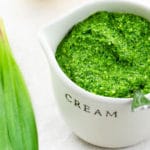Ramp Pesto with Basil and Spinach
Ramp pesto is my first move the minute these fleeting delicacies appear in the local shops. Our favorite version also incorporates basil and spinach for a well-rounded, big-batch recipe.
Servings: 6
Calories: 214kcal
Ingredients
- ½ cup (60 grams) pine nuts
- 5 ounces 142 grams/about 3 cups sliced and packed ramps
- 1 ½ ounces 43 grams/2 gently packed cups basil leaves
- 1 gently packed cup baby spinach leaves 1 ¼ ounces
- ½ teaspoon fine sea salt
- Juice of 1 lemon 3 tablespoons/(45 ml)
- ½ cup (120 ml) extra-virgin olive oil
- ½ cup 2 ounces/(57 grams) grated pecorino cheese
Instructions
- Place the pine nuts in a small, dry pan over medium heat. Toast until lightly browned in spots, stirring or tossing in the pan occasionally, about five minutes. Keep a close eye on them so they don't burn. Let cool slightly.
- Pour toasted pine nuts into a standard (10-ish cup) food processor fitted with the blade.
- Add ramps, basil, spinach, salt, and lemon juice to the food processor.
- Pulse until finely chopped, stopping to encourage ingredients through the blade and scrape down the sides as necessary.
- With the machine running, pour in the olive oil.
- Add cheese and pulse to incorporate or stir in with a spoon.
Notes
- Buying ramp leaves rather than whole ramps with the bulbs still attached is the best way to ensure they've been harvested sustainably. That said, you can 100% use either version in this recipe. If using whole ramps, trim any roots and chop the bulbs, stems and leaves into bite-sized pieces
- A little bit of baby spinach magically helps the pesto retain its vibrant green color. Along with basil, it also helps balance the flavors. Weigh the basil leaves after picking them off the stems.
- Use pecorino, parmesan or a combination. Pecorino (made with sheep's milk) is a little bit saltier and tangier, while parmesan is a bit sweeter. They both work very well in pesto.
- Variations: If pine nuts are hard to come by, you can use toasted walnuts or pecans, almonds, or even sunflower seeds or pepitas. // To change up the balance of flavors, you can use more ramps and less spinach. // You can add more olive oil for a saucier consistency. // Or try making a smaller batch in a mortar and pestle, which will leave the ingredients more roughly chopped. It's a totally different experience from the exact same ingredients.
- Due to its lemony vibe and top-secret spinach, this pesto will keep well in an airtight container in the fridge for up to a week. Place it into a container, smooth out the top with a spatula, and pour a thin layer of olive oil overtop before positioning the lid.
- Freeze in pint-size deli containers or in ice cube trays for smaller portions. If using ice cube trays, transfer to an airtight container once frozen solid. If you end up with a ton of ramps, this is a great way to preserve them for up to a year.
- Serving suggestions: Stir it into a piping hot bowl of past. Slather it onto a grilled chicken sandwich. Tuck some into an omelet. Or use it anywhere you'd use basil pesto.
Nutrition
Calories: 214kcal | Carbohydrates: 6.7g | Protein: 6.4g | Fat: 19.1g | Fiber: 1.7g
